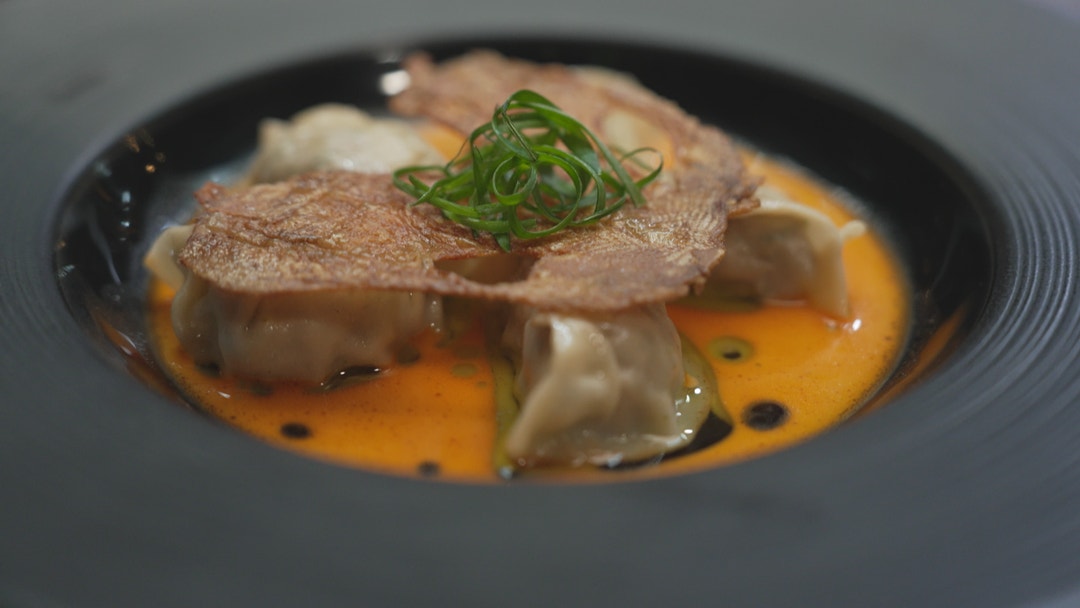Back
Quail & Nectarine Dumplings

- Steps
- Ingredients
Ingredients
Dumpling Dough
Spring Onion and Fennel Seed Oil
Crispy Quail Skin
Nduja Sauce
Select All
Steps
- Heat oil in a medium saucepan. Cut through the spine of the quails, remove spines and transfer to the saucepan. Carefully slide your fingers in between the skin and meat to remove the skin from one quail. Set aside.
- Remove the wings and add them to the saucepan. Place the flesh in a food processor and set aside. Roughly chop the bones and place in the pan. Fry bones to a deep brown colour.
- Chop spring onions into three parts, remove the roots and white stems, then chop the green part into two. Roughly chop the white part and roots and place in the pan, with the quail. Take the middle green parts and weigh 25g for the Spring Onion Oil. Place the remaining middle parts in the food processor, with the quail. For the top of the spring onion, finely slice them length ways and soak in iced water to curl the garnish for plating. Set aside.
- Roughly chop two nectarines and place one in the food processor. Transfer the other nectarine to the saucepan with the quail and the spring onion.
- Peel parsnips and add the peel to the pan with thyme and two cups of water. Simmer on a medium-low heat for 15-20 minutes or until the stock is reduced by half and nice and glossy. Strain and set aside.
- Add salt and pepper to the food processor, blend ingredients together until well combined and the meat is evenly chopped. Transfer into a bowl, cover with cling film and refrigerate until needed.
- For the Dumpling Dough, combine the flour and warm water with a pinch of salt in a large bowl. Mix with a fork or chopsticks. When it starts to roughly come together, knead for 5 minutes, then form into a tight ball, cover, and rest for at least 15 minutes.
- Once rested, divide the dough into quarters and roll each quarter into a ball. Flatten each ball lightly and put it through the pasta machine, laminate until the second last setting of the pasta machine. Once laminated, dust the bench and dough with flour.
- With a 9cm cookie cutter, cut large circles to make dumpling wrappers. Lightly dust the wrappers with flour and place onto a plate, cover with a tea towel. Fill each dumpling with about 1 ½ teaspoons of filling, wet the outside area of the dumpling and fold them to your liking. Keep dumplings under a tea towel to prevent drying out.
- For the Spring Onion and Fennel Seed Oil, heat grapeseed oil in a small saucepan. Finely slice the reserved spring onions and add to the saucepan with salt, and fennel seeds. Heat on medium-low heat until it starts to bubble, and you can smell the spring onions cooking. Transfer into a stick mixer cannister and allow to cool slightly. Blend with a stick mixer for at least 3 minutes until very smooth. Strain and set aside.
- To make the Crispy Quail Skin, heat a small fry pan on a medium heat. Add fennel seeds and toast until they start to develop a darker colour. Transfer into a spice grinder and grind until fine. Combine ½ teaspoon of the processed fennel with ½ teaspoon of salt in a small bowl.
- Heat a sandwich press and lightly brush the skin with oil and place on the base of the press. Cook until crispy. Transfer to paper towel and sprinkle with the fennel salt.
- For the Nduja Sauce, heat a medium saucepan and add butter and nduja. Sauté until butter has melted then add prepared stock. Simmer for a few minutes on low. Add cream, season to taste and set aside in a jug.
- To cook the dumplings, select a large fry pan that has a lid to fit. Heat 1 tsp of oil on a medium heat and then fry the dumplings. Cook for about 3 minutes or until the bottom starts to become golden. Then add about ¼ cup of water and cover the pan immediately. Cook the dumplings for a further 3 minutes, then lift the lid off and cook on medium-low heat until the water has completely evaporated. Set aside.
- To serve, place 5 dumplings, bottom down into a shallow bowl. Drizzle spring onion and fennel seed oil around the dumplings. Place the crispy quail skin in the centre on top of the dumplings. Remove spring onion curls from water and gently pat dry with a paper towel. Place on top of the quail skin.
























